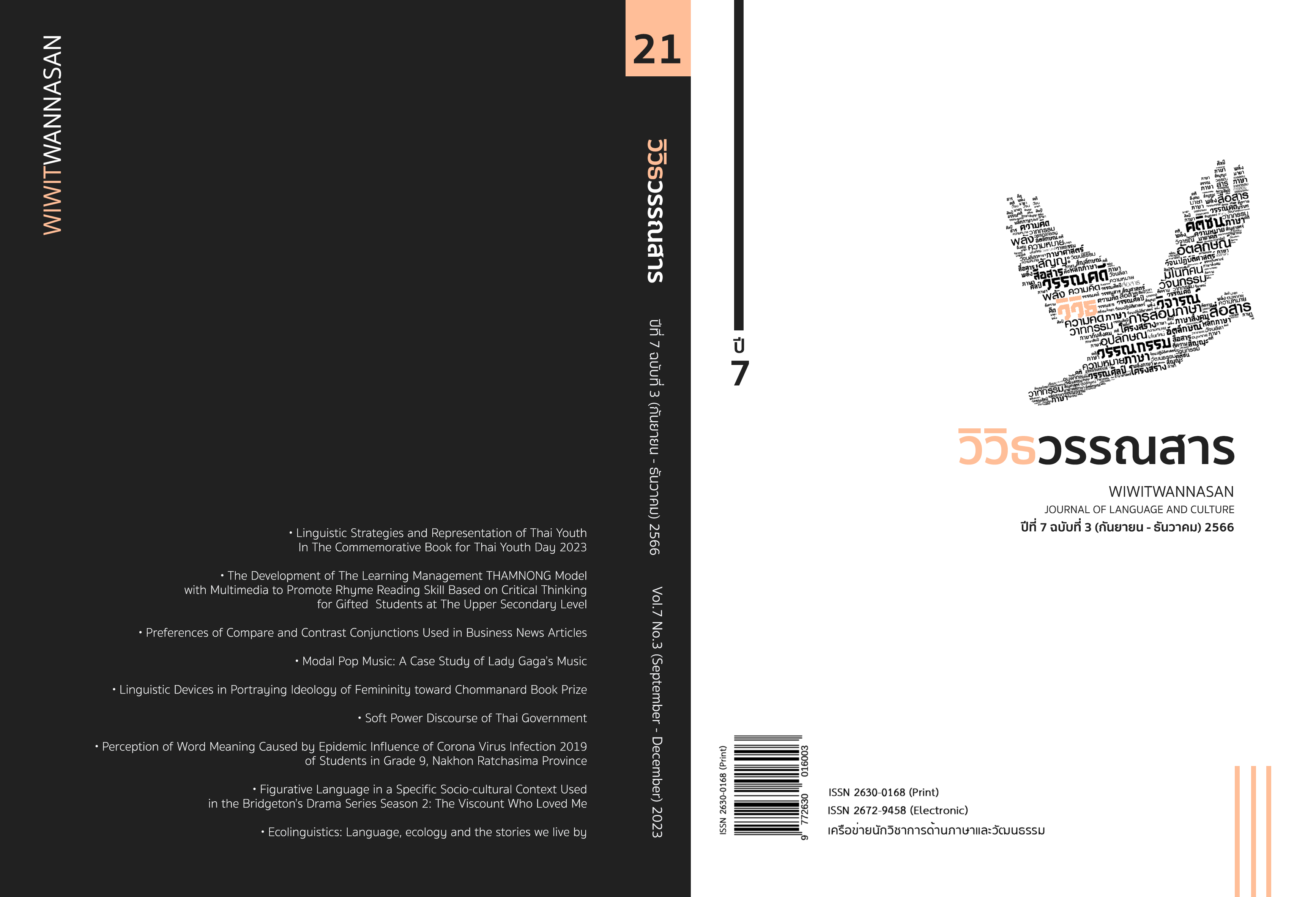ความชอบในการเลือกใช้คำเชื่อมเชิงเปรียบเทียบและเชิงขัดแย้งที่ถูกใช้ในบทความข่าวธุรกิจ
Main Article Content
บทคัดย่อ
งานวิจัยนี้ศึกษาความชอบในการเลือกใช้คำเชื่อมเชิงเปรียบเทียบและเชิงขัดแย้งในบทความข่าวธุรกิจ งานวิจัยครั้งนี้เลือกบทความที่แตกต่างออกไปได้ศึกษาศึกษาวิธีการใช้คำเชื่อมเชิงเปรียบเทียบและเชิงขัดแย้งในบทความข่าวธุรกิจที่เขียนเป็นภาษาอังกฤษ ชุดข้อมูลในงานวิจัยครั้งนี้ถูกเก็บรวบรวมมาจากข่าวธุรกิจในหนังสือพิมพ์ The New York Times ซึ่งเป็นหนังสือพิมพ์ที่คนอเมริกันรู้จักเป็นอย่างแพร่หลาย หนังสือพิมพ์จำนวนทั้งสิ้น 10 ฉบับถูกสุ่มรวบรวมระหว่างวันที่ 1 มกราคม 2566 ถึง 10 มีนาคม 2566 การวิเคราะห์ชุดข้อมูลในงานวิจัยครั้งนี้ทำตามแบบหลักการการใช้จริงตามแบบของ Swan (2016) ซึ่งเป็นผู้เชี่ยวชาญด้านภาษาศาสตร์ประยุกต์ เพื่อให้การวิเคราะห์ข้อมูลคำเชื่อมเชิงเปรียบเทียบและเชิงขัดแย้งดำเนินไปอย่างถูกต้อง จึงได้ขอให้นักภาษาศาสตร์ประยุกต์จำนวนทั้งสิ้นสามคนตรวจสอบความถูกต้องของข้อมูลโดยวิธีวิเคราะห์ความสอดคล้องของข้อมูลกับจุดประสงค์การวิจัย ผลการศึกษาแสดงให้เห็นว่าการใช้คำเชื่อมเชิงเปรียบเทียบและเชิงขัดแย้งในบทความข่าวธุรกิจปรากฏเป็นจำนวนร้อยละ 39.44 และร้อยละ 60.65 จำนวนการใช้คำเชื่อมที่พบนี้เป็นไปตามหลักการของการเขียนอย่างไม่เป็นทางการและความต่อเนื่อง จำนวนร้อยละที่สูงกว่าสะท้อนให้เห็นการใช้จริงที่มากกว่าของการใช้คำเชื่อเชิงขัดแย้งในบทความข่าวธุรกิจ นักวิจัยหวังเป็นอย่างยิ่งว่าผลการวิจัยนี้จะเป็นประโยชน์ต่อผู้เรียนภาษาอังกฤษเป็นภาษาต่างประเทศ (EFL Learners) ในการใช้คำเชื่อมเชิงเปรียบเทียบและเชิงขัดแย้งในการเขียนภาษาอังกฤษเชิงธุรกิจได้อย่างเหมาะสม
Article Details

อนุญาตภายใต้เงื่อนไข Creative Commons Attribution-NonCommercial-NoDerivatives 4.0 International License.
ลิขสิทธิ์ของบทความเป็นของวารสาร การพิมพ์ซ้ำจะต้องได้ร้บการอนุญาตจากบรรณาธิการวารสาร
เอกสารอ้างอิง
Darweesh, A. D. D. (2016). Iraqi EFL learners’ using conjunction as cohesive devices. Journal
of Education and Practice, 7 (11), 169-180.
Dehham, S. H. (2015). An analytical study of errors committed by Iraqi EFL learners in using
contrastive conjunctives, Journal of Human Sciences, 1 (1), 37-64.
Dirgeyasa, I. W. (2016). Genre-based approach: What and how to teach and to learn
writing. English Language Teaching, 9 (9), 45-51.
Forsyth, P. (2009). Effective Business Writing. USA: Kogan Page.
Halliday, M. A. K. (1989). Spoken and written language. Oxford: Oxford University Press
Hassoon, N. H. (2023). Conjunctions in Iragi media EFL classroom. Social Science Journal,
(1), 2943-2956.
Jone, J. (2016). How do I write a compare and contrast essay?: From Start to Finish.
USA: J Rembrandt International.
Radford, A. (2009). An Introduction of English Sentence Structures. Cambridge: Cambridge
University Press.
Reeves, J. (2004). Like everybody else: Equalizing educational opportunity for English
language learners. Tesol Quarterly, 38(1), 43-66.
Singchai, P., & Juturapitakkul, N. (2016). Cohesion in narrative essay writing of EFL secondary
students in Thailand. The New English Teacher, 10 (2), 89-111.
Swan, M. (2016). Practical English Usage. Oxford: Oxford University Press.
Wongkittiporn, A., & Chitrakara, N. (2019). Control constructions in British and American
English. Bulletin of the Transilvania University of Brasov. Series IV: Philology and Cultural Studies, 3 (1), 19-48.
Wongkittiporn, A. (2022). Semantic Interpretations of Passive Constructions in Business News
Articles. Journal of Language Religion and Culture, 11 (2), 1-29.


